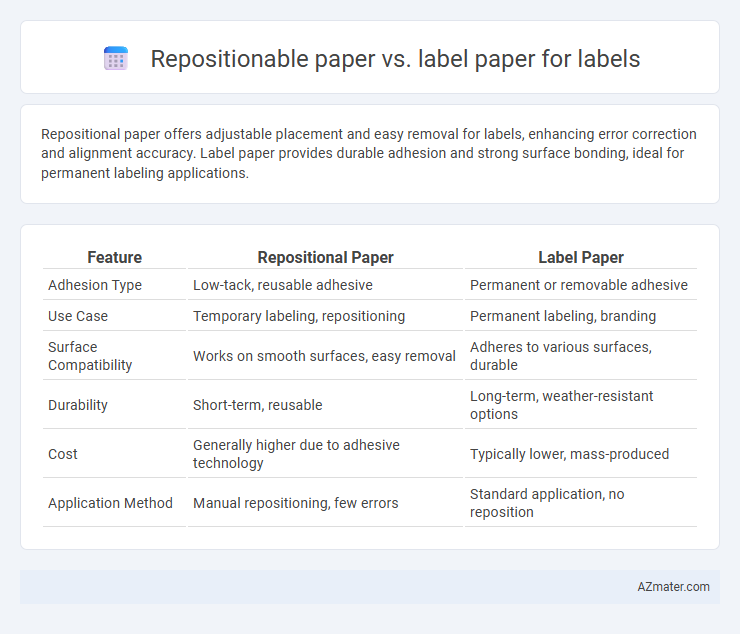Repositional paper offers adjustable placement and easy removal for labels, enhancing error correction and alignment accuracy. Label paper provides durable adhesion and strong surface bonding, ideal for permanent labeling applications.
Table of Comparison
| Feature | Repositional Paper | Label Paper |
|---|---|---|
| Adhesion Type | Low-tack, reusable adhesive | Permanent or removable adhesive |
| Use Case | Temporary labeling, repositioning | Permanent labeling, branding |
| Surface Compatibility | Works on smooth surfaces, easy removal | Adheres to various surfaces, durable |
| Durability | Short-term, reusable | Long-term, weather-resistant options |
| Cost | Generally higher due to adhesive technology | Typically lower, mass-produced |
| Application Method | Manual repositioning, few errors | Standard application, no reposition |
Introduction to Repositional Paper and Label Paper
Repositional paper features a low-tack adhesive allowing labels to be easily removed and repositioned without residue, making it ideal for temporary labeling and frequent updates. Label paper typically uses a permanent adhesive designed for long-lasting application on various surfaces, ensuring durability and resistance to peeling. Both materials are selected based on the intended label lifespan and surface compatibility, with repositional paper favored for flexible usage and label paper chosen for permanence.
Key Differences Between Repositional and Label Paper
Repositional paper is designed with an adhesive that allows labels to be easily removed and repositioned without leaving residue, making it ideal for temporary labeling and adjustments. Label paper features a permanent adhesive that securely bonds to surfaces, ensuring durability and long-lasting identification. The key difference lies in the adhesive properties, with repositional paper prioritizing flexibility and reusability, while label paper emphasizes strong, permanent adhesion.
Material Composition and Texture
Repositional paper features a silicone-coated backing that allows labels to be easily lifted and repositioned without leaving residue, making it ideal for temporary labeling applications. Label paper typically consists of a clay-coated or uncoated paper face with a permanent adhesive, providing a smooth texture that ensures clear printing and strong adhesion suitable for long-term use. The material composition and surface finish directly affect label durability, print quality, and application flexibility in these two paper types.
Adhesive Properties: Comparisons and Applications
Repositional paper features a low-tack adhesive that allows labels to be easily peeled off and reapplied multiple times without leaving residue, making it ideal for temporary labeling and testing applications. Label paper typically uses a permanent adhesive designed for long-term adhesion on various surfaces, ensuring durability and resistance to environmental factors. Selection between repositional and label paper depends on application requirements, with repositional suited for flexibility and repositioning, while label paper provides strong, lasting bonds for permanent labeling needs.
Print Compatibility and Quality
Repositional paper offers moderate print compatibility with standard inkjet and laser printers, allowing easy label removal and repositioning without residue, though print quality may slightly vary depending on ink absorption. Label paper is designed for optimal print quality across various printing technologies, including thermal transfer and direct thermal printers, providing sharp, durable images and text for professional labeling needs. Selecting between repositional and label paper depends on the required print technology and the desired balance between repositioning flexibility and print permanence.
Usage Scenarios: When to Choose Each Type
Repositional paper is ideal for temporary label applications such as indoor product labeling, price tags, and promotional stickers where easy removal and repositioning without residue are essential. Label paper offers a permanent adhesive solution suitable for long-term use on packaging, shipping labels, and asset tagging that require durability and strong adhesion. Selecting between repositional and label paper depends on whether the label needs to be temporary and repositionable or fixed and long-lasting.
Durability and Reusability
Repositionable paper offers moderate durability with a low-tack adhesive designed for temporary labeling, allowing easy removal and reuse without leaving residue, making it ideal for short-term applications. Label paper provides higher durability with permanent adhesives and stronger materials, ensuring long-lasting labels suitable for harsh environments but typically limits reusability once applied. Choosing between the two depends on whether the priority is on label longevity or the ability to reposition and reuse labels multiple times.
Cost Considerations and Budgeting
Repositional paper often incurs higher costs due to its specialized adhesive technology designed for easy removal and reuse, making it ideal for temporary labeling applications. Label paper, typically used for permanent labels, tends to be more economical and suitable for high-volume printing, contributing to lower overall expenses for large projects. Budgeting should account for the intended label lifespan and application frequency, balancing initial material costs against potential savings from reuse or durability.
Environmental Impact and Sustainability
Repositional paper for labels often uses adhesives designed for temporary bonding, which can complicate recycling processes due to residual sticky substances that contaminate paper recycling streams. Label paper with permanent adhesive generally adheres more cleanly during manufacturing and disposal, enabling easier removal and better recycling compatibility, reducing environmental impact. Choosing label paper with recyclable or biodegradable materials contributes significantly to sustainability goals by minimizing waste and enhancing resource recovery in waste management systems.
Final Recommendations: Repositional vs Label Paper
Repositional paper offers the advantage of easy label adjustment and repositioning without leaving residue, making it ideal for temporary or frequently changed labels. Label paper provides stronger adhesion and durability, suitable for permanent labeling needs and long-term use. For final recommendations, choose repositional paper when flexibility and repositioning are priorities, while label paper is best for lasting adhesion and professional appearance.

Infographic: Repositional paper vs Label paper for Label
 azmater.com
azmater.com